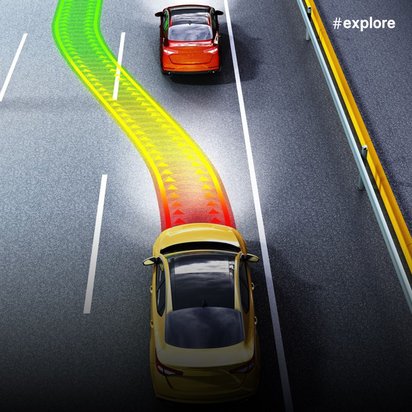Checklist
Improving safety as standard
These assistance systems will become mandatory for new cars starting in July. More on #explore.

Checklist
These assistance systems will become mandatory for new cars starting in July. More on #explore.

19. May 2022
The EU has set itself the goal of reducing road traffic accidents. This is why various assistance systems in cars will become mandatory from this year. From 6 July 2022, this obligation will initially apply to all new vehicle types, i.e., new or updated passenger car models that come onto the market. From 7 July 2024, these systems will also have to be installed in all newly registered vehicles. Read on for an overview of what these assistance systems can do and how they work.
The intelligent speed assist is designed to help drivers maintain the maximum permitted speed. The system uses camera-based traffic sign recognition and digital maps, for example from navigation services, to determine how fast the host car may drive in which situation. If the driver exceeds the speed limit, they are warned by visual and acoustic cues.
If the car unintentionally leaves its lane, the emergency lane-keeping assist comes into play: first with a warning, then by actually taking the wheel. Unlike the familiar lane-keeping assist, it intervenes more aggressively as soon as an emergency situation has been detected: for example, it will steer the car decisively to safety if the vehicle is threatening to go off the road or wander into the oncoming traffic. According to the EU regulation, the emergency lane-keeping warning system switches off automatically if it cannot work reliably, “in particular due to deficiencies in the road infrastructure”. When the vehicle restarts, the assistant is reactivated.
Reversing assists are intended to make parking manoeuvres safer in confusing situations or at other times when reversing is needed. They can use cameras or sensors to detect passers-by or obstacles behind the vehicle and issue visual, acoustic or haptic warnings.
If a driver reacts too late or fails to react in dangerous situations or is over-hesitant in braking, the emergency brake assist steps in. It brakes independently to prevent collisions or at least to soften their impact. This is made possible by methods for optical distance and speed measurement such as radar, LiDAR and cameras, whose data are evaluated by a control unit. The mandatory emergency brake assist must at least be able to detect obstacles and moving vehicles in front of the car. In a second phase, it will also be required to identify pedestrians or cyclists. It is not yet clear when these stricter requirements will become mandatory.

According to studies, fatigue is responsible for almost one in five accidents, falling asleep at the wheel for almost every fourth fatal car accident on German motorways. The fatigue warning system is intended to prevent those accidents that occur when a driver dozes off for an instant or loses concentration. By analysing steering behaviour and the movements of the eyes and eyelids, the system can draw conclusions about the driver’s attentiveness. In the event of signs of fatigue or decreasing concentration, it specifically warns the driver and recommends taking that overdue break – for example by displaying the familiar coffee cup.
“Alcolocks”, i.e., alcohol-sensitive immobilisers, will not be mandatory, at least not initially. However, manufacturers must install a standardised interface, using which such an immobiliser can be retrofitted. Alcohol measuring devices are therefore not part of the EU regulation. Existing systems can measure levels of alcohol in the breath and will only activate the ignition once a positive sample has been recorded.
In the future, cars will be required to have a data storage device installed that can be used to reconstruct accidents, like the black box found in aircraft. For this purpose, the data are stored immediately before, during and after a collision. The information recorded includes the speed, position and inclination of the vehicle, the use of the brakes, the condition of the assistance systems and the data from the eCall system. These data may also be made available to national authorities for the purpose of accident research and must therefore be stored securely and anonymously.
It isn’t always immediately possible to tell when the driver in front is going to slam on the brakes. The emergency brake light, also known as adaptive brake light, is intended to reduce the risk of rear-end collisions by warning the following traffic in the event of an emergency braking manoeuvre. Unlike in normal braking, the brake lights do not light up permanently, flashing at a high frequency several times per second instead. This happens in the event of an ongoing deceleration of over six metres per square second and at a speed of over 50 kilometres per hour. If the vehicle comes to a complete stop, the hazard warning lights are automatically switched as an additional way of warning the following traffic. The emergency brake light is activated in response to pressure on, and the travel of, the brake pedal as well as the control units of the anti-lock braking system (ABS) and the Electronic Stability Program (ESP).
This is an article from #explore. #explore is a digital journey of discovery into a world that is rapidly changing. Increasing connectivity, innovative technologies, and all-encompassing digitalization are creating new things and turning the familiar upside down. However, this also brings dangers and risks: #explore shows a safe path through the connected world.